coolant temperature Mercury Marauder 2003 Owner's Manuals
[x] Cancel search | Manufacturer: MERCURY, Model Year: 2003, Model line: Marauder, Model: Mercury Marauder 2003Pages: 232, PDF Size: 2.29 MB
Page 9 of 232
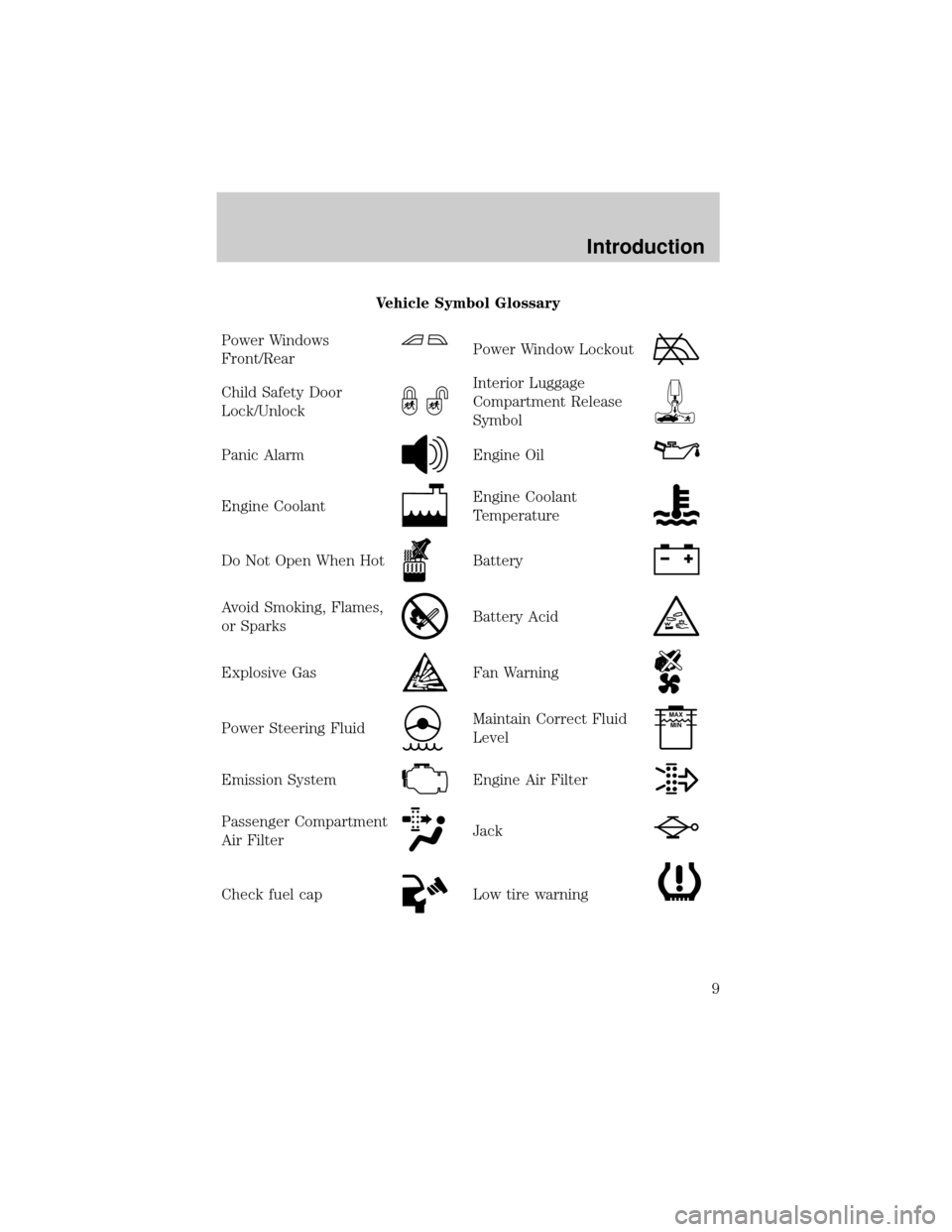
Vehicle Symbol Glossary
Power Windows
Front/Rear
Power Window Lockout
Child Safety Door
Lock/UnlockInterior Luggage
Compartment Release
Symbol
Panic AlarmEngine Oil
Engine CoolantEngine Coolant
Temperature
Do Not Open When HotBattery
Avoid Smoking, Flames,
or SparksBattery Acid
Explosive GasFan Warning
Power Steering FluidMaintain Correct Fluid
LevelMAX
MIN
Emission SystemEngine Air Filter
Passenger Compartment
Air FilterJack
Check fuel capLow tire warning
Introduction
9
Page 13 of 232
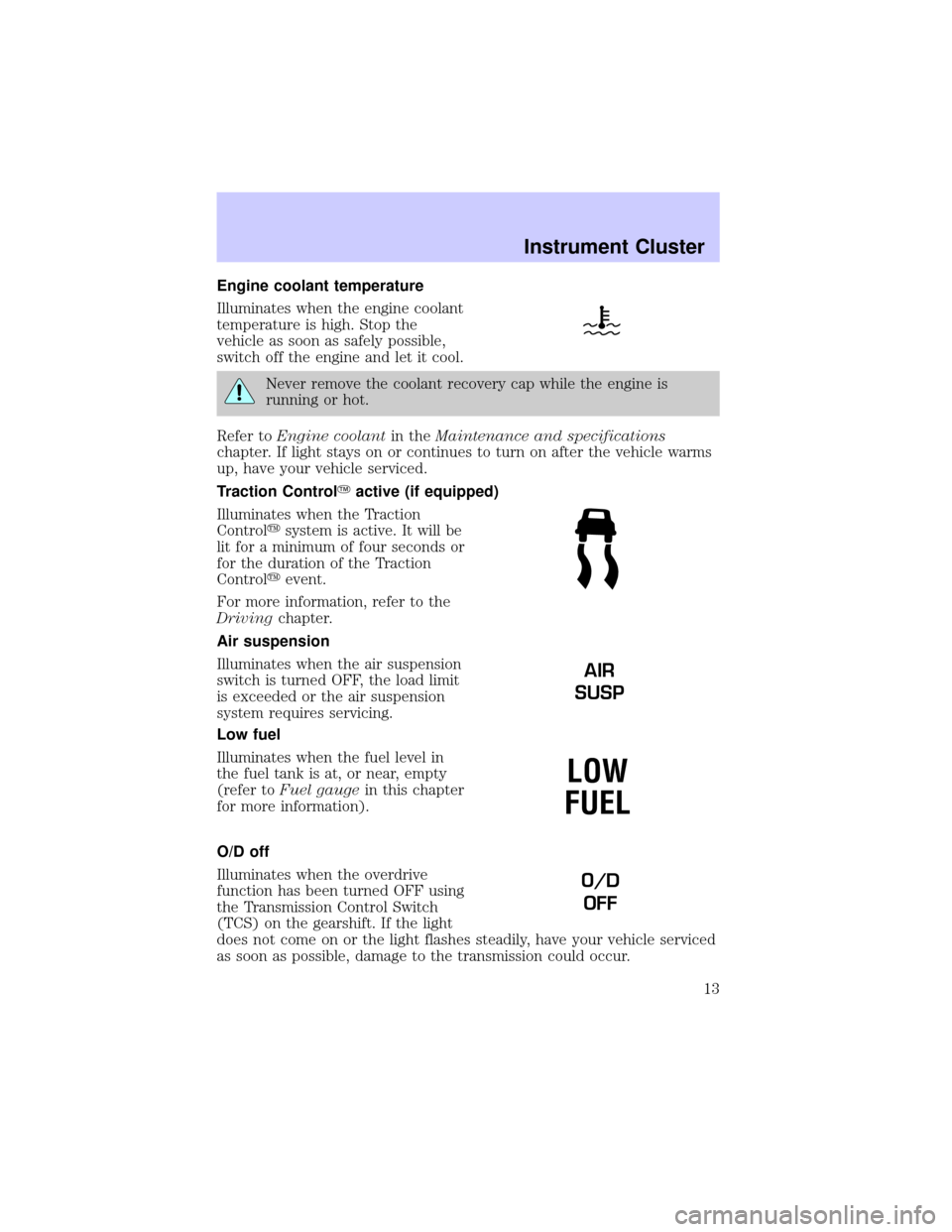
Engine coolant temperature
Illuminates when the engine coolant
temperature is high. Stop the
vehicle as soon as safely possible,
switch off the engine and let it cool.
Never remove the coolant recovery cap while the engine is
running or hot.
Refer toEngine coolantin theMaintenance and specifications
chapter. If light stays on or continues to turn on after the vehicle warms
up, have your vehicle serviced.
Traction ControlYactive (if equipped)
Illuminates when the Traction
Controlysystem is active. It will be
lit for a minimum of four seconds or
for the duration of the Traction
Controlyevent.
For more information, refer to the
Drivingchapter.
Air suspension
Illuminates when the air suspension
switch is turned OFF, the load limit
is exceeded or the air suspension
system requires servicing.
Low fuel
Illuminates when the fuel level in
the fuel tank is at, or near, empty
(refer toFuel gaugein this chapter
for more information).
O/D off
Illuminates when the overdrive
function has been turned OFF using
the Transmission Control Switch
(TCS) on the gearshift. If the light
does not come on or the light flashes steadily, have your vehicle serviced
as soon as possible, damage to the transmission could occur.
AIR
SUSP
LOW
FUEL
O/D
OFF
Instrument Cluster
13
Page 15 of 232
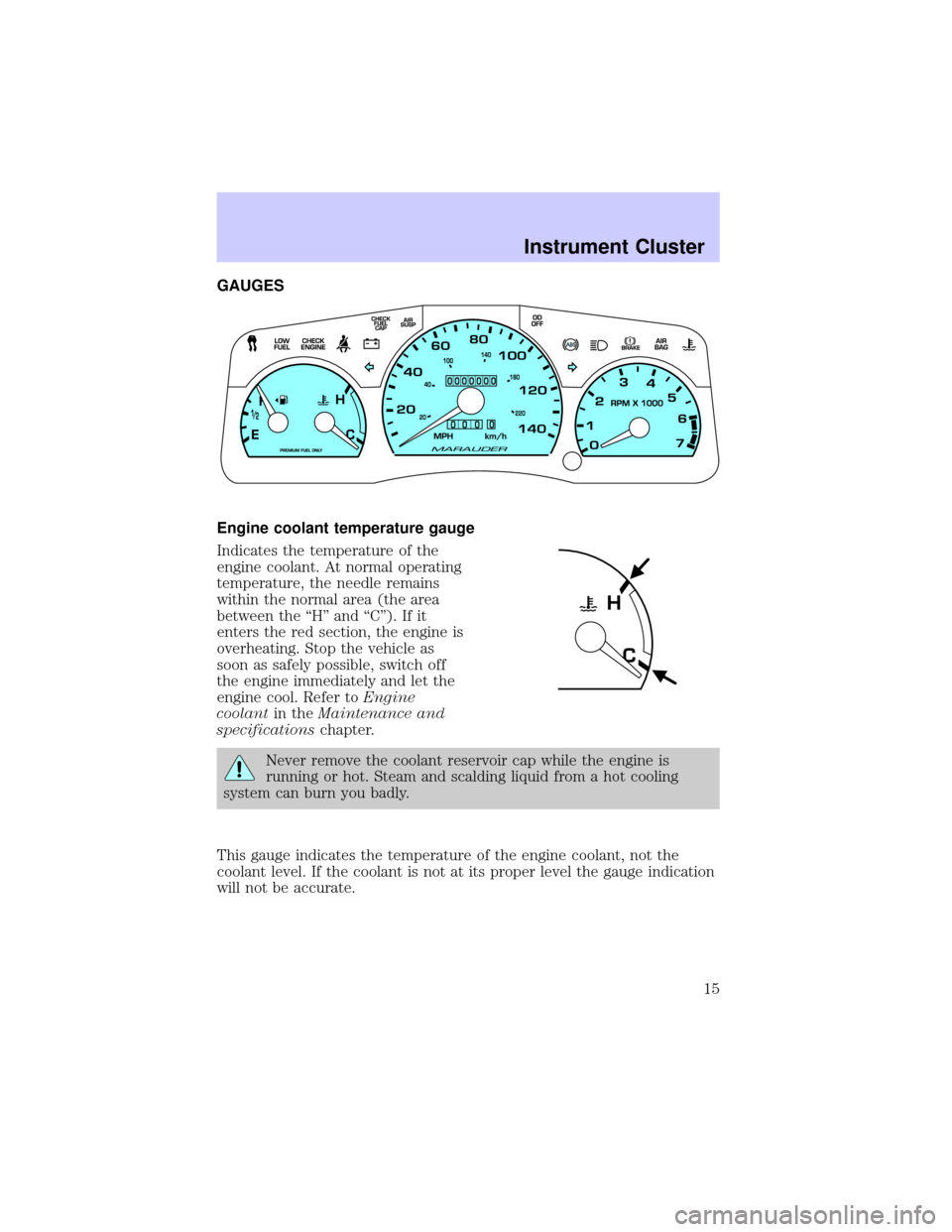
GAUGES
Engine coolant temperature gauge
Indicates the temperature of the
engine coolant. At normal operating
temperature, the needle remains
within the normal area (the area
between the ªHº and ªCº). If it
enters the red section, the engine is
overheating. Stop the vehicle as
soon as safely possible, switch off
the engine immediately and let the
engine cool. Refer toEngine
coolantin theMaintenance and
specificationschapter.
Never remove the coolant reservoir cap while the engine is
running or hot. Steam and scalding liquid from a hot cooling
system can burn you badly.
This gauge indicates the temperature of the engine coolant, not the
coolant level. If the coolant is not at its proper level the gauge indication
will not be accurate.
C
H
Instrument Cluster
15
Page 182 of 232
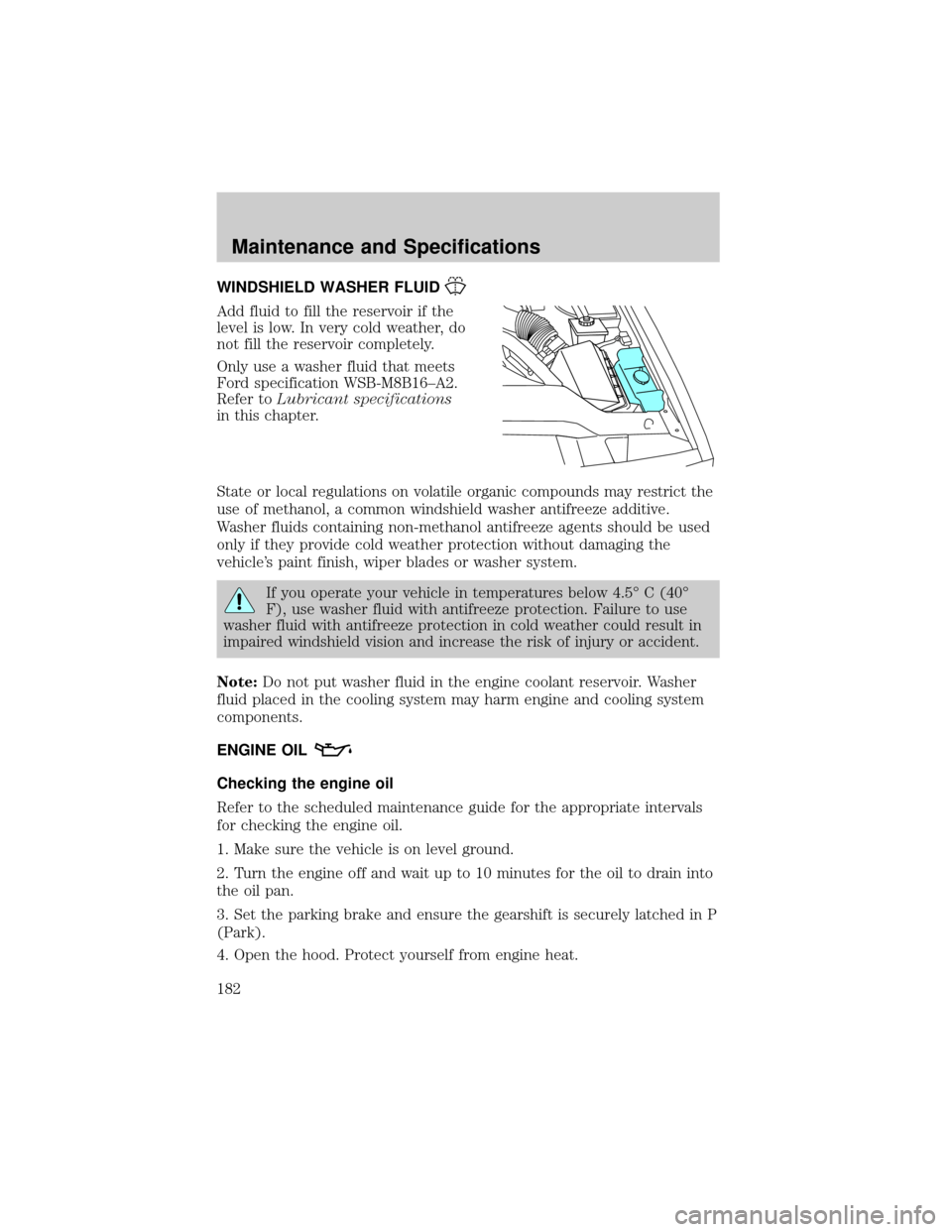
WINDSHIELD WASHER FLUID
Add fluid to fill the reservoir if the
level is low. In very cold weather, do
not fill the reservoir completely.
Only use a washer fluid that meets
Ford specification WSB-M8B16±A2.
Refer toLubricant specifications
in this chapter.
State or local regulations on volatile organic compounds may restrict the
use of methanol, a common windshield washer antifreeze additive.
Washer fluids containing non-methanol antifreeze agents should be used
only if they provide cold weather protection without damaging the
vehicle's paint finish, wiper blades or washer system.
If you operate your vehicle in temperatures below 4.5É C (40É
F), use washer fluid with antifreeze protection. Failure to use
washer fluid with antifreeze protection in cold weather could result in
impaired windshield vision and increase the risk of injury or accident.
Note:Do not put washer fluid in the engine coolant reservoir. Washer
fluid placed in the cooling system may harm engine and cooling system
components.
ENGINE OIL
Checking the engine oil
Refer to the scheduled maintenance guide for the appropriate intervals
for checking the engine oil.
1. Make sure the vehicle is on level ground.
2. Turn the engine off and wait up to 10 minutes for the oil to drain into
the oil pan.
3. Set the parking brake and ensure the gearshift is securely latched in P
(Park).
4. Open the hood. Protect yourself from engine heat.
Maintenance and Specifications
182
Page 193 of 232

Used engine coolant should be disposed of in an appropriate
manner. Follow your community's regulations and standards for recycling
and disposing of automotive fluids.
Coolant refill capacity
To find out how much fluid your vehicle's cooling system can hold, refer
toRefill capacitiesin this chapter.
Fill your engine coolant reservoir as outlined inAdding engine coolant
in this chapter.
Severe climates
If you drive in extremely cold climates (less than ±36É C [±34É F]):
²It may be necessary to increase the coolant concentration
above 50%.
²NEVER increase the coolant concentration above 60%.
²Increased engine coolant concentrations above 60% will
decrease the overheat protection characteristics of the engine
coolant and may cause engine damage.
²Refer to the chart on the coolant container to ensure the
coolant concentration in your vehicle will provide adequate
freeze protection at the temperatures in which you drive in the
winter months.
If you drive in extremely hot climates:
²It is still necessary to maintain the coolant concentration
above 40%.
²NEVER decrease the coolant concentration below 40%.
²Decreased engine coolant concentrations below 40% will
decrease the corrosion protection characteristics of the engine
coolant and may cause engine damage.
²Decreased engine coolant concentrations below 40% will
decrease the freeze protection characteristics of the engine
coolant and may cause engine damage.
²Refer to the chart on the coolant container to ensure the
coolant concentration in your vehicle will provide adequate
protection at the temperatures in which you drive.
Vehicles driven year-round in non-extreme climates should use a 50/50
mixture of engine coolant and distilled water for optimum cooling system
and engine protection.
Maintenance and Specifications
193
Page 203 of 232
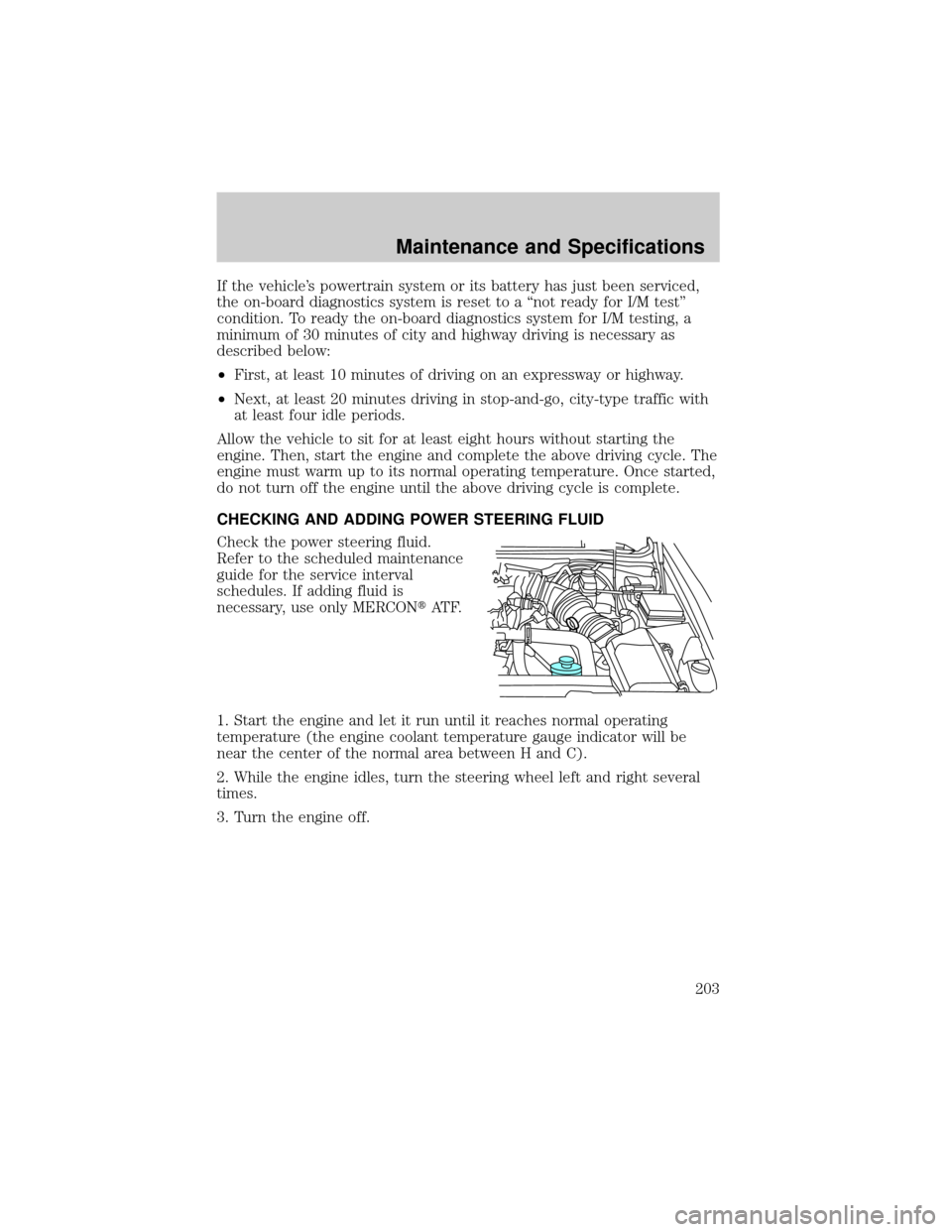
If the vehicle's powertrain system or its battery has just been serviced,
the on-board diagnostics system is reset to a ªnot ready for I/M testº
condition. To ready the on-board diagnostics system for I/M testing, a
minimum of 30 minutes of city and highway driving is necessary as
described below:
²First, at least 10 minutes of driving on an expressway or highway.
²Next, at least 20 minutes driving in stop-and-go, city-type traffic with
at least four idle periods.
Allow the vehicle to sit for at least eight hours without starting the
engine. Then, start the engine and complete the above driving cycle. The
engine must warm up to its normal operating temperature. Once started,
do not turn off the engine until the above driving cycle is complete.
CHECKING AND ADDING POWER STEERING FLUID
Check the power steering fluid.
Refer to the scheduled maintenance
guide for the service interval
schedules. If adding fluid is
necessary, use only MERCONtAT F.
1. Start the engine and let it run until it reaches normal operating
temperature (the engine coolant temperature gauge indicator will be
near the center of the normal area between H and C).
2. While the engine idles, turn the steering wheel left and right several
times.
3. Turn the engine off.
Maintenance and Specifications
203
Page 222 of 232

Child safety seats ......................114
attaching with tether
straps .......................................118
in front seat ............................116
in rear seat ..............................116
Cleaning your vehicle
engine compartment ..............174
instrument panel ....................176
interior .....................................177
interior trim ............................176
plastic parts ............................175
washing ....................................173
waxing .....................................173
wheels ......................................174
wiper blades ............................176
Climate control (see Air
conditioning or Heating) ............33
Clock ............................................24
Compass, electronic
set zone adjustment .................53
Console ........................................74
overhead ..............................51±52
Controls
power seat .................................89
steering column ........................67
Coolant
checking and adding ..............188
coolant temperature light ........13
refill capacities ................193, 211
specifications ..................212, 214
Cruise control
(see Speed control) ....................63
Customer Assistance ................142
Ford accessories for your
vehicle .....................................178
Ford Extended Service
Plan ..........................................165Getting assistance outside
the U.S. and Canada ..............169
Getting roadside assistance ...142
Getting the service you
need .........................................163
Ordering additional owner's
literature .................................170
The Dispute Settlement
Board .......................................166
Utilizing the
Mediation/Arbitration
Program ...................................169
D
Daytime running lamps
(see Lamps) ................................39
Defrost
rear window ..............................37
Dipstick
automatic transmission
fluid ..........................................204
engine oil .................................182
Doors
lubricant specifications ..........212
Driving under special
conditions ..................................135
through water .........................136
E
Emergencies, roadside
jump-starting ..........................156
Emission control system ..........201
Engine ........................................214
check engine/service engine
soon light ..................................10
cleaning ...................................174
coolant .....................................188
Index
222
Page 223 of 232

idle speed control ...................186
lubrication
specifications ..................212, 214
refill capacities ........................211
service points ..........................181
starting after a collision .........143
Engine block heater .................125
Engine oil ..................................182
change oil soon warning,
message center .......................182
checking and adding ..............182
dipstick ....................................182
filter, specifications ........184, 211
recommendations ...................184
refill capacities ........................211
specifications ..................212, 214
Exhaust fumes ..........................125
F
Floor mats ...................................74
Fluid capacities .........................211
Foglamps .....................................39
Fuel ............................................194
calculating fuel
economy ............................55, 198
cap .....................................11, 196
capacity ...................................211
choosing the right fuel ...........196
comparisons with EPA fuel
economy estimates .................201
detergent in fuel .....................198
filling your vehicle with
fuel ...........................194, 196, 198
filter, specifications ........198, 211
fuel filler door override ............73
fuel filler door release ..............72
fuel pump shut-off switch .....143gauge .........................................17
improving fuel economy ........198
low fuel warning light ..............13
octane rating ...................197, 214
quality ......................................197
running out of fuel .................198
safety information relating to
automotive fuels .....................194
Fuses ..................................144±145
G
Garage door opener ....................68
Gas cap (see Fuel cap) ......11, 196
Gas mileage (see Fuel
economy) ...................................198
Gauges .........................................15
battery voltage gauge ...............16
engine coolant temperature
gauge .........................................15
engine oil pressure gauge ........16
fuel gauge ..................................17
odometer ...................................17
speedometer .............................17
tachometer ................................18
trip odometer ............................18
GAWR (Gross Axle Weight
Rating) .......................................136
definition .................................136
driving with a heavy load ......136
location ....................................136
GVWR (Gross Vehicle Weight
Rating) .......................................136
calculating ...............................136
definition .................................136
driving with a heavy load ......136
location ....................................136
Index
223